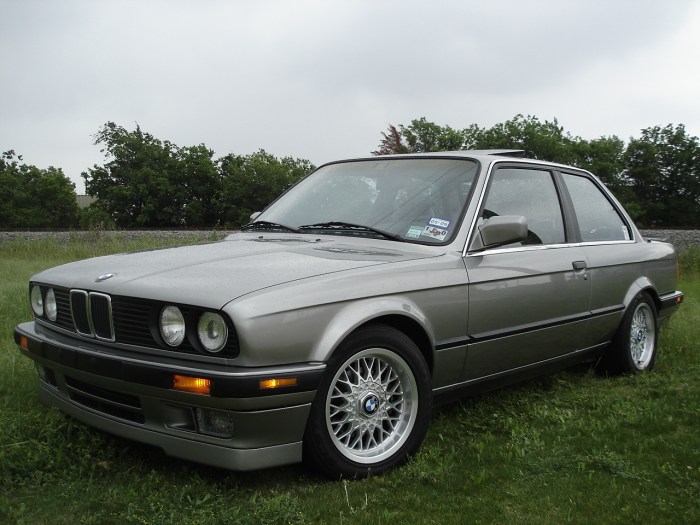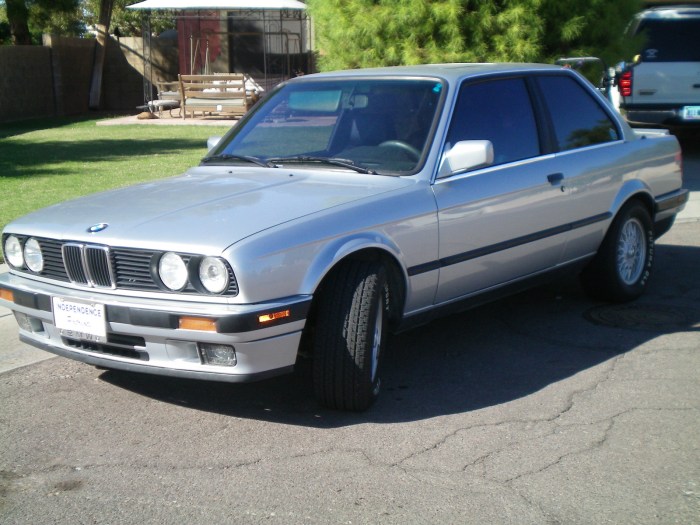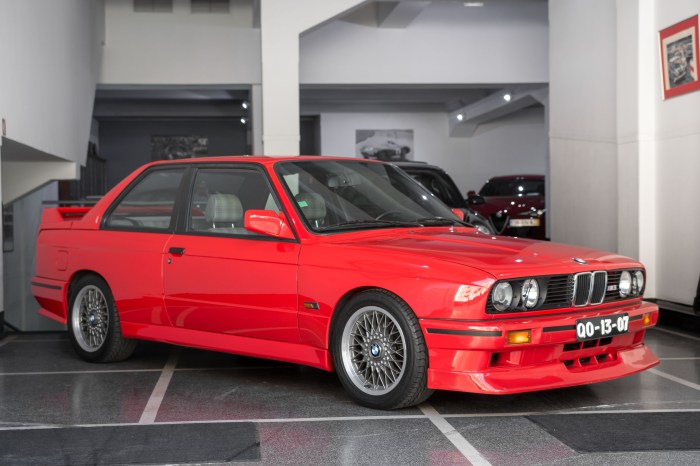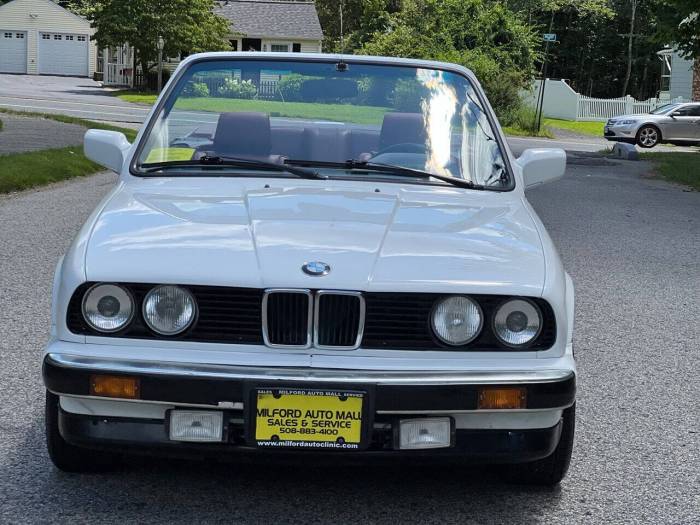The 1988 BMW 3 Series, a name synonymous with driving pleasure and timeless design, continues to captivate enthusiasts decades after its debut. This generation marked a pivotal moment in BMW’s history, introducing a refined and sophisticated driving experience that solidified the 3 Series’ position as a benchmark in the luxury compact segment.
From its iconic E30 body style to its range of powerful engines, the 1988 3 Series offers a compelling blend of performance, practicality, and enduring appeal.
The 1988 3 Series showcased BMW’s commitment to engineering excellence. It offered a range of engine options, including the spirited 318i and the more powerful 325i, each delivering a distinct driving character. The car’s handling, a hallmark of BMW’s philosophy, was praised for its precision and responsiveness.
The 3 Series was a car that truly connected driver and machine, offering a level of engagement that was unmatched in its class.
Overview: 1988 BMW 3 Series
The 1988 BMW 3 Series, a cornerstone of the brand’s legacy, marked a significant evolution in the automotive landscape. This generation, known internally as the E30, solidified the 3 Series’ reputation as a driver’s car, blending performance, handling, and practicality in a way that resonated with enthusiasts and everyday drivers alike.
This model year was characterized by subtle refinements and updates that enhanced both the car’s aesthetic appeal and its driving dynamics. The 1988 3 Series, however, retained the core design principles that had established its success.
Design and Features
The 1988 BMW 3 Series continued to embody the brand’s design language, characterized by a clean, elegant aesthetic with a focus on functionality. The E30’s design, penned by the renowned designer Claus Luthe, showcased a balanced and harmonious combination of curves and sharp lines.
The distinctive kidney grille, a BMW signature, was prominent, while the sloping roofline and short overhangs contributed to the car’s sporty profile.The interior of the 1988 3 Series emphasized driver-centric ergonomics. The dashboard was well-organized, with clear instrumentation and easy-to-reach controls.
The focus on driver comfort and functionality was evident in the well-designed seats and the spacious cabin.
Notable Features
The 1988 3 Series offered a range of engine options, catering to diverse driver preferences. The base model was powered by a 1.6-liter four-cylinder engine, while more powerful options included a 1.8-liter four-cylinder and a 2.0-liter four-cylinder. The performance-oriented 325i featured a 2.5-liter six-cylinder engine that delivered impressive power and acceleration.
The 1988 BMW 3 Series, a compact executive car, marked a significant shift in the brand’s design philosophy. While its predecessor emphasized comfort and luxury, the E30 generation prioritized driving dynamics and handling. This focus on performance continued to evolve in subsequent models, culminating in the powerful and sophisticated 2001 BMW 5 Series.
The E39 5 Series, as it was known, further cemented BMW’s reputation for building driver-centric vehicles, building upon the legacy established by the E30 3 Series.
The 1988 3 Series introduced several notable features that enhanced its driving experience. These included:
- Anti-lock braking system (ABS): This advanced safety feature, available as an option, provided enhanced braking control in challenging conditions.
- Power steering: The introduction of power steering made the 3 Series easier to maneuver at low speeds, improving its overall driving experience.
- Sports suspension: The optional sports suspension package offered a firmer ride and enhanced handling capabilities, making the 3 Series even more enjoyable to drive.
Engine and Performance

The 1988 BMW 3 Series offered a range of powerful and efficient engines, catering to various driving preferences. From the spirited four-cylinder options to the more potent six-cylinder units, each engine variant provided a unique blend of performance and fuel economy.
Engine Options and Performance Characteristics
The 1988 BMW 3 Series was available with a variety of engine options, each offering distinct performance characteristics.
- 318i:This base model featured a 1.8-liter four-cylinder engine producing 105 horsepower. While not the most powerful option, it provided a smooth and efficient driving experience, making it a suitable choice for daily commutes and fuel-conscious drivers.
- 325i:This popular variant boasted a 2.5-liter six-cylinder engine generating 168 horsepower. The 325i offered a more spirited driving experience, with ample power for highway cruising and overtaking. It also delivered impressive fuel economy for a six-cylinder engine.
- 325iX:This all-wheel-drive version of the 325i offered enhanced traction and stability, particularly in challenging weather conditions. It retained the same 2.5-liter six-cylinder engine as the standard 325i, providing a similar level of performance.
Engine Specifications
The table below summarizes the key specifications for each engine option available in the 1988 BMW 3 Series:
| Model | Engine | Horsepower | Torque (lb-ft) | Fuel Economy (city/highway/combined) |
|---|---|---|---|---|
| 318i | 1.8L I4 | 105 hp | 108 lb-ft | 22/30/25 mpg |
| 325i | 2.5L I6 | 168 hp | 164 lb-ft | 19/27/22 mpg |
| 325iX | 2.5L I6 | 168 hp | 164 lb-ft | 18/25/21 mpg |
Exterior and Interior Design

The 1988 BMW 3 Series, a model that solidified the brand’s reputation for sporty driving and refined design, carried forward the classic lines of its predecessors while introducing subtle updates that reflected the evolving automotive landscape.
Exterior Styling
The 1988 BMW 3 Series boasted a design that was both timeless and forward-thinking. Its sharp lines and sculpted curves conveyed a sense of dynamism and athleticism, traits that would become synonymous with the brand. The distinctive kidney grille, a hallmark of BMW design, was flanked by sleek headlights that emphasized the car’s aggressive stance.
The long hood and short overhangs further emphasized the 3 Series’ sporty character. The rear end was characterized by a sloping roofline and taillights that extended into the rear fenders, contributing to the car’s overall streamlined appearance.
Interior Features and Amenities
The 1988 BMW 3 Series offered a driver-focused interior that prioritized functionality and comfort. The dashboard was designed with a clear layout, featuring an array of analog gauges and controls that were easily accessible. The seats were supportive and well-padded, offering a comfortable ride even on long journeys.
The standard features included power windows, power locks, and air conditioning. Higher trim levels offered additional amenities such as a sunroof, leather upholstery, and a premium sound system.
Trim Levels and Features, 1988 BMW 3 Series
The 1988 BMW 3 Series was available in a variety of trim levels, each offering a unique combination of features and amenities. Here is a table that compares the different trim levels and their respective features:| Trim Level | Engine | Transmission | Features ||—|—|—|—|| 318i | 1.8L I4 | 5-speed manual | Power windows, power locks, air conditioning || 325i | 2.5L I6 | 5-speed manual | Power windows, power locks, air conditioning, sunroof, leather upholstery || 325iX | 2.5L I6 | 5-speed manual | Power windows, power locks, air conditioning, sunroof, leather upholstery, all-wheel drive |
Driving Experience

The 1988 BMW 3 Series, despite its age, retains a driving experience that’s both engaging and rewarding. Its handling and dynamics, while not as refined as modern counterparts, still offer a level of precision and responsiveness that’s hard to find in other cars of its era.
Ride Quality and Comfort
The 1988 3 Series’ ride quality is firm but not harsh. The suspension, designed for sporty handling, can transmit some road imperfections into the cabin, but it’s never uncomfortable. The seats are supportive and comfortable for long drives, and the cabin is well-insulated from road noise.
The 1988 BMW 3 Series marked a significant evolution for the brand, building upon the legacy of its predecessors like the iconic 1973 BMW 2002. While the 2002 was known for its nimble handling and sporty character, the 3 Series expanded on this formula with a more refined and sophisticated approach, offering a wider range of body styles and engine options.
This evolution solidified the 3 Series as a cornerstone of BMW’s lineup, establishing it as a benchmark for the premium compact segment.
The 3 Series’ ride quality is a testament to BMW’s commitment to balance, offering a blend of sportiness and comfort that’s still enjoyable today.
The 1988 BMW 3 Series marked a turning point for the brand, with its sharp styling and refined handling making it a popular choice among drivers. While the 3 Series was known for its on-road prowess, BMW also had a strong legacy in motorcycles, exemplified by the 1976 BMW R Series , which featured a powerful boxer engine and a comfortable riding experience.
The 1988 3 Series, however, was a testament to BMW’s ability to excel in both automotive and motorcycle segments, showcasing the brand’s commitment to innovation and performance across different platforms.
Handling and Driving Dynamics
The 1988 3 Series is known for its precise handling and engaging driving dynamics. The car’s steering is direct and communicative, providing excellent feedback to the driver. The suspension, while firm, offers a good balance between comfort and handling. The 3 Series’ handling is characterized by its responsiveness and predictability, making it a joy to drive on winding roads.
Legacy and Impact

The 1988 BMW 3 Series left an indelible mark on the automotive landscape, establishing a legacy that continues to influence BMW’s design philosophy and the entire luxury sports sedan segment. Its innovative engineering, refined driving dynamics, and timeless design have earned it a place among the most influential cars of the late 20th century.
Cultural Significance
The 1988 3 Series transcended its status as a mere automobile, becoming a cultural icon. Its sleek lines, sporty handling, and luxurious interior resonated with a generation seeking both performance and sophistication. It was embraced by enthusiasts, drivers, and even celebrities, solidifying its image as a symbol of success and style.
Its influence extended beyond the automotive realm, inspiring fashion, music, and popular culture.
Impact on Subsequent BMW Vehicles
The 1988 3 Series served as a blueprint for future generations of BMW vehicles, particularly the 3 Series itself. Its emphasis on driving dynamics, rear-wheel drive, and a balanced blend of performance and luxury became hallmarks of the brand. Subsequent 3 Series models built upon the foundation laid by the 1988 model, incorporating advancements in technology, safety, and efficiency while retaining the core principles of driving engagement and sophistication.
Awards and Recognitions
The 1988 BMW 3 Series garnered widespread acclaim, receiving numerous awards and recognitions. Notably, it was named “Car of the Year” by several prominent automotive publications, including “Motor Trend” and “AutoWeek,” further solidifying its position as a benchmark in the luxury sports sedan segment.
Collecting and Restoration

The 1988 BMW 3 Series, a classic example of German engineering and timeless design, has gained significant traction in the collector car market. Its popularity stems from its blend of performance, reliability, and enduring appeal, making it a desirable addition to any enthusiast’s garage.
Market Value and Collector Interest
The value of a 1988 BMW 3 Series varies greatly depending on several factors, including condition, mileage, model variant, and modifications. The most sought-after models are the E30 M3, a high-performance variant with a powerful 2.3-liter four-cylinder engine, and the 325i, known for its balanced performance and handling.
Original, low-mileage examples in excellent condition can command premium prices, exceeding $20,000 in some cases. However, restored or modified examples may also attract significant interest, particularly if they showcase unique features or improvements.
Restoration Challenges and Maintenance Tips
Restoring a 1988 BMW 3 Series can be a rewarding but challenging endeavor. Common issues include finding original parts, addressing rust, and ensuring proper mechanical functionality. Here are some tips for maintaining the vehicle’s condition:
- Regular Maintenance:Adhering to a strict maintenance schedule is crucial. This includes regular oil changes, filter replacements, and inspections of key components like brakes, suspension, and cooling systems.
- Rust Prevention:The E30 chassis is known for its susceptibility to rust. Regularly inspect the undercarriage, wheel wells, and body panels for signs of corrosion and address them promptly.
- Original Parts:While aftermarket parts are readily available, using original BMW parts whenever possible ensures the best fit and performance. Sourcing parts from reputable dealers or online marketplaces can be helpful.
Factors Influencing Value
Here’s a table outlining the key factors that influence the value of a 1988 BMW 3 Series:
| Factor | Description | Impact on Value |
|---|---|---|
| Condition | Overall condition, including bodywork, paint, interior, and mechanical components | Excellent condition commands higher prices, while neglected vehicles are worth less. |
| Mileage | Lower mileage generally translates to better condition and higher value. | High-mileage examples may be less desirable, especially if they haven’t been properly maintained. |
| Model Variant | Certain models, such as the E30 M3 or 325i, are more sought-after and command higher prices. | Rare or limited-edition models may be particularly valuable. |
| Modifications | Modifications can either enhance or diminish the value, depending on their quality and relevance. | Authentic, period-correct modifications can increase value, while poorly executed or aftermarket parts may lower it. |
| Documentation | Original service records, owner’s manuals, and other documentation can add value. | A complete and well-maintained history can demonstrate the car’s care and authenticity. |
Closure

The 1988 BMW 3 Series remains a cherished classic, its timeless design and driving dynamics continuing to resonate with enthusiasts. Whether you’re seeking a piece of automotive history or a rewarding driving experience, the 3 Series offers a compelling proposition.
Its legacy as a benchmark for performance and luxury continues to inspire generations of drivers, cementing its place as a true icon in the automotive world.